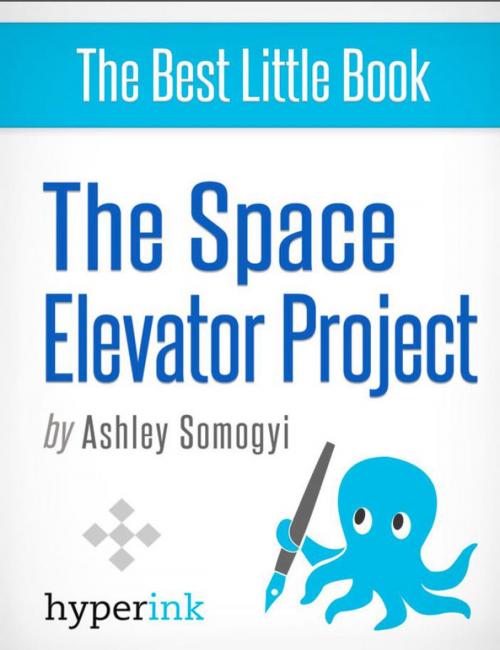| Author: | Ashley Somogyi | ISBN: | 9781614648901 |
| Publisher: | Hyperink | Publication: | February 29, 2012 |
| Imprint: | Hyperink | Language: | English |
| Author: | Ashley Somogyi |
| ISBN: | 9781614648901 |
| Publisher: | Hyperink |
| Publication: | February 29, 2012 |
| Imprint: | Hyperink |
| Language: | English |
ABOUT THE BOOK
The Orbital Space Elevator Project is an ongoing international endeavour to create a ground to space mechanical system that would allow man and materials to be transported into space without the use of rockets or jet propulsion. Using a laser based system, a transport vehicle would be propelled into space along a super material with over 100 times the strength of steal. This system would allow man to travel into space with as much ease, frequency, and cost as little as shipping a package to a different continent.
I will soon explain to you the nearly unimaginable possibilities of a this system and how it can alter mankind's position in the universe. I have studied matters of physics at length and can be rightfully labeled a theoretical science enthusiast. In order to approach this topic with the correct frame of mind, I encourage you suspend disbelief. One cannot grasp the intention of theoretical science by applying the current limitations of human ingenuity. The whole purpose of the word “theoretical” is to give notice of something that is within the grasp of human capability but has yet to be realized by our ingenuity.
EXCERPT FROM THE BOOK
The orbital station would sit in geostationary orbit and be the terminal point of the climber, or car, that would bring people and objects up into space. The propulsion method of the climber itself is another area of interest and concern. At the yearly Climber (Power Beaming) Competition and Tether Strength Competition, scientists from all over the world assemble and bring in prototypes of their climber systems in hopes of winning the $500,000 prize. In 2009, a Seattle-based group, LaserMotive, won $900,000 at NASA’s Centennial Challange when their laser powered robot climbed a 900-meter-long cable, suspended from a helicopter – in 7.5 minutes.
Proposed methods vary widely with most stemming from a manner of laser driven propulsion, not dissimilar from the kind used in your laser DVD player. Others have proposed a track system akin to those of high speed magnetic railway lines. While a considerable portion of laser research is done by the military, they have said that they are very open to the idea of using lasers in more civilian, non-military capacities. The laser’s power generation is proposed to be driven by varied sources such as solar rays bounced off enormous mirrors, to heat based lasers. Depending on the method of propulsion, the estimated travel time between Earth and the orbital station could be anywhere from five hours to a seven and a half days...
Buy a copy to keep reading!
ABOUT THE BOOK
The Orbital Space Elevator Project is an ongoing international endeavour to create a ground to space mechanical system that would allow man and materials to be transported into space without the use of rockets or jet propulsion. Using a laser based system, a transport vehicle would be propelled into space along a super material with over 100 times the strength of steal. This system would allow man to travel into space with as much ease, frequency, and cost as little as shipping a package to a different continent.
I will soon explain to you the nearly unimaginable possibilities of a this system and how it can alter mankind's position in the universe. I have studied matters of physics at length and can be rightfully labeled a theoretical science enthusiast. In order to approach this topic with the correct frame of mind, I encourage you suspend disbelief. One cannot grasp the intention of theoretical science by applying the current limitations of human ingenuity. The whole purpose of the word “theoretical” is to give notice of something that is within the grasp of human capability but has yet to be realized by our ingenuity.
EXCERPT FROM THE BOOK
The orbital station would sit in geostationary orbit and be the terminal point of the climber, or car, that would bring people and objects up into space. The propulsion method of the climber itself is another area of interest and concern. At the yearly Climber (Power Beaming) Competition and Tether Strength Competition, scientists from all over the world assemble and bring in prototypes of their climber systems in hopes of winning the $500,000 prize. In 2009, a Seattle-based group, LaserMotive, won $900,000 at NASA’s Centennial Challange when their laser powered robot climbed a 900-meter-long cable, suspended from a helicopter – in 7.5 minutes.
Proposed methods vary widely with most stemming from a manner of laser driven propulsion, not dissimilar from the kind used in your laser DVD player. Others have proposed a track system akin to those of high speed magnetic railway lines. While a considerable portion of laser research is done by the military, they have said that they are very open to the idea of using lasers in more civilian, non-military capacities. The laser’s power generation is proposed to be driven by varied sources such as solar rays bounced off enormous mirrors, to heat based lasers. Depending on the method of propulsion, the estimated travel time between Earth and the orbital station could be anywhere from five hours to a seven and a half days...
Buy a copy to keep reading!















